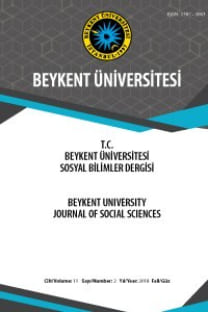MAVİ YAKALI VE BEYAZ YAKALI ÇALIŞANLARIN TÜKENMİŞLİK İLE ÖFKE YÖNETİMLERİ İLİŞKİSİ
THE RELATIONSHIP of BURNOUT and ANGER MANAGEMENT of BLUE-COLLARED AND WHITE-COLLARED EMPLOYEES
Burnout, Anger Anger Management,
___
- Akten, S. (2007). Rehber Öğretmenlerin Mesleki Tükenmişlik Düzeylerinin İncelenmesi.(Yüksek Lisans Tezi). Trakya Üniversitesi Sosyal BilimlerEnstitüsü, Edirne.
- Alessandri, G., Perinelli, E., De Longis, E., Schaufeli, W. B., Theodorou, A., Borgogni, L., Caprara, G. V.andCinque, L. (2018). JobBurnout: TheContribution of EmotionalStabilityandEmotional Self-EfficacyBeliefs, Journal of OccupationalandOrganizationalPsychology, 91(4), 823-851.
- Berkowitz, L. (1993). Aggression: ItsCauses, Consequencesand Control, New York: McGraw-Hill.
- Bunge, C. A. (1989). Stressin the Library Workplace, Library Trends, 38(1), 92-102.
- Chetlen, A. L., Chan, T. L., Ballard, D. H., Frigini, L. A., Hildebrand, A., Kim, S.andGaneshan, D. (2019). AddressingBurnout in Radiologists, AcademicRadiology, 26(4), 526-533.
- Charoensukmongkol, P., Moqbel, M., Gutierrez-Wirsching, S. andShankar, R. (2016).TheRole of CoworkerandSupervisorSupport on JobBurnoutandJobSatisfaction, Journal of Advances in Management Research.
- De La Fuente-Solana, E. I., Gomez-Urquıza, J. L., Canadas, G. R, Albendin-Garcia, L., Ortega-Campos, E.andCanadas-De La Fuente, G. A. (2017). BurnoutandItsRelationshipwithPersonalityFactors in OncologyNurses, EuropeanJournal of OncologyNurses, 30, 91-96.
- Fan, Yang, Xıaodong, L.,Yımın, Z., Yulong, L. andChunlın, W.(2017). JobBurnout of Construction Project Managers in China: A Cross-Sectional Analysis, Science Direct International Journal of Project Management, 35,1272-1287.
- Jonsdottır, I. H., Rodjer, L., Hadzıbajramovıc, E., Borjesson, M. andAhlborgJr, G. (2010).A ProspectiveStudy of Leisure-Time Physical Activity andMentalHealth in SwedishHealthCareWorkersandSocialInsuranceOfficers,PreventiveMedicine, 51(5),373-377.
- Kerr, M. A. andSchneider, B. H. (2008). AngerExpression in ChildrenandAdolescents: A Review of theEmpiricalLiterature, ClinicPsychologyRev, 28, 559-577.
- Kinman, G., Wray, S. andStrange, C. (2011). EmotionalLabour, BurnoutandJobSatisfaction in UK Teachers: The Role of WorkplaceSocialSupport, EducationalPsychology, 31(7), 843-856.
- Krıstensen T. S., Hannerz, H., Hogh, A.andBorg, V. (2005). TheCopenhagenPsychosocialQuestionnaire -A Toolfor the Assessment and Improvement of the Psychosocial Work Environment, Scand Journal of Work, Environment & Health, 31, 438-449.
- KMTSO, Kahramanmaraş Ticaret ve Sanayi Odası, http://www.kmtso.org.tr/firma/mgrup (07.05.2021).
- Lingard, H. (2003). TheImpact of Individualand Job Characteristics on ‘Burnout’ AmongCivilEngineers in AustraliaandTheImplicationsforEmployeeTurnover, Construction Management andEconomics, 21(1),69-80.
- Maslach, C, Schaufeli, B. W. andLeiter, P. M. (2001). JobBurnout, AnnualReview of Psychology, 52(1), 397-422.
- Maslach,C. andJackson, S. E., (1981). TheMeasurement of ExperiencedBurnout,Journal of OrganizationalBehavior, 2(2), 99-113.
- Nel, P. andKotze, M. (2017). TheInfluence of PsychologicalResources on Mineworkers’ Levels of Burnout in A Remote andIsolatedMiningTown in South Africa, TheExtractiveIndustriesandSociety, 4(4), 885-892.
- Novaco, R. W. (1975). Anger Control: The Development and Evaluation of An ExperimentalTreatment, Lexington. Nunnally, J. (1978). PsychometricTheory, New York: McGraw-Hill.
- Özyeşil, Z. (2012). FiveFactorPersonalityTraits as Predictor of TraitAngerandAngerExpression, EducationandScience, 37(163), 322-332.
- Raja, S. andStein, S. L., (2014). Work-life Balance: History, CostsandBudgetingforBalance, Clinics in ColonandRectalSurgery, 27 (2), 71-74.
- Spielberger, C. D., Jacobs, G., Russell, S. andCrane, R. S. (1983). Assessment of Anger: TheState-TraitAngerScale, Advances in PersonalityAssessment, 2,159-187.
- Spielberger,C. D., Reheiser, E. C. andSydeman, S. J. (1995). MeasuringTheExperience, Expressionand Control of Anger, ComprehensiveNursing, 18(3),207-132.
- Storlie, F. J. (1979). Burnout: TheElaboration of aConcept, AJN TheAmericanJournal of Nursing, 79(12), 2108-2111.
- Wilde, J. (2006). Öfke Sorunu Yaşayan Çocuklara Yönelik Uygulamalar,Ankara Üniversitesi Eğitim Bilimleri Fakültesi Dergisi, 39(1),135-152.
- ISSN: 1307-5063
- Yayın Aralığı: Yılda 2 Sayı
- Başlangıç: 2007
- Yayıncı: Beykent Üniversitesi
GÜVENLİK İKLİMİNİN BELİRLEYİCİLERİ: DEMOGRAFİK FAKTÖRLER, HİYERARŞİK KÜLTÜR VE ÖRGÜTSEL ÖZDEŞLEŞME
Ali GÜRSOY, Mustafa Kemal TOPCU
MAVİ YAKALI VE BEYAZ YAKALI ÇALIŞANLARIN TÜKENMİŞLİK İLE ÖFKE YÖNETİMLERİ İLİŞKİSİ
TÜRKİYE’DE KADIN GİRİŞİMCİLERİN VE FİNANSMAN ALTERNATİFLERİNİN ANALİZİ
